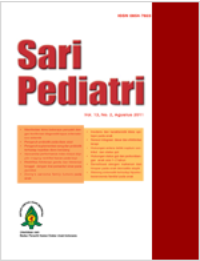Faktor Risiko Timbulnya Inhibitor Faktor VIII pada Anak dengan Hemofilia A
Sari
Latar belakang. Proses timbulnya inhibitor bersifat multifaktorial, baik genetik maupun lingkungan.
Beberapa studi telah dilakukan untuk mengetahui faktor risiko terbentuknya inhibitor, namun masih terdapat
pendapat yang kontroversial. Di Indonesia, skrining inhibitor tidak rutin dilakukan karena keterbatasan biaya
dan alat, sehingga diperlukan suatu penelitian yang dapat dijadikan acuan pemeriksaan inhibitor selektif.
Tujuan. Mengetahui prevalensi , karakteristik klinis, dan faktor risiko timbulnya inhibitor pada anak dengan
hemofilia A di Departemen IKA- RSCM.
Metode. Uji potong lintang dilakukan pada anak usia ≤18 tahun di Pusat Hemofilia Terpadu IKA-RSCM. Analisis
bivariat dilakukan dengan uji Fisher. Analisis multivariat tidak dilakukan karena tidak memenuhi syarat.
Hasil. Empatpuluh subjek penelitian, didapatkan prevalensi inhibitor 37,5% (15/40). Rentang usia subjek
10 (1,5-18) tahun, usia saat diagnosis hemofilia pertama kali ditegakkan 8 bulan, dan saat pertama kali
mendapat terapi faktor VIII pada inhibitor positif 9 bulan. Hampir seluruh subjek (39/40) mendapat terapi
konsentrat plasma, 11/15 subjek dengan inhibitor positif mendapat terapi pertama kali sebelum berusia 1
tahun, 14/15 subjek merupakan hemofilia berat, sebagian besar (12/15) mendapat manifestasi perdarahan
sendi. Suku bangsa ibu, Jawa, lebih sering ditemukan pada inhibitor positif (8/15). Tidak ditemukan hasil
yang bermakna secara statistik antara faktor risiko dengan timbulnya inhibitor.
Kesimpulan. Prevalensi inhibitor 37,5%, inhibitor positif lebih sering ditemukan pada pasien hemofilia berat
yang mendapat terapi pertama kali sebelum berusia 1 tahun. Penelitian kami tidak berhasil membuktikan faktor
risiko bermakna untuk timbulnya inhibitor pada anak dengan hemofilia A.
Kata Kunci
Teks Lengkap:
PDFReferensi
The World federation of Hemophilia. Diagnosis and
management of inhibitors to factor VIII and IX: an
introductory discussion for physicians. California: The
World Federation of Hemophilia; 2004.
Van de Berg. Risk of inhibitor development in children with
hemophilia A. European Hematology. 2007;1:8-10.
Van den Berg SC. The multifactorial etiology of inhibitor
development in hemophilia: genetics and environment.
Semin Thromb Hemost 2009;35:723-34.
Lorenzo JI, Lopez A, Altisent C, Aznar JA. Incidence
of factor VIII inhibitors in severe hemophilia:
the importance of patient age. Br J Haematol
;113:600-3.
Van der Bom JG, Mauser-Bunschoten EP, Fischer K,
Van den Berg HM. Age at first treatment and immune
tolerance to factor VIII in severe hemophilia. Thromb
Haemost 2003;89:475–9.
Goudemand J, Rothschild C, Demiguel V. Influence of
the type of factor VIII concentrate on the incidence of
factor VIII inhibitors in previously untreated patients
with severe hemophilia A. Blood 2006;107:46–51.
Gouw SC, Born JG, Auerswald G, Ettinghausen CE,
Tedgard U, Berg HM. Recombinant versus plasmaderived factor VIII products and the development
of inhibitors in previously untreated patients with
severe hemophilia A: the CANAL cohort study. Blood
;109:4693-7.
Ragni MV, Ojeifo O, Feng J, Yan J, Hill KA, Sommer SS,
dkk. Risk factors for inhibitor formation in hemophilia: a
prevalent case-control study. Hemophilia 2009;15:1074-82.
Addiego J, Kasper C, Abildgaard C. Increased frequency
of inhibitors in African-American hemophilia A patients.
Blood 1994;84:239.
Aledort LM, DiMichele DM. Inhibitors occur more
frequently in African-American and Latino hemophiliacs.
Hemophilia 1998;4:68.
Xue F, Zhang L, Sui T. Factor VIII gene mutations profile
in 148 Chinese hemophilia A subjects. Eur J Hematol
;85:264-72.
Chen YC, Hu SH, Cheng SN, Chao TY. Genetic analysis
of haemophilia A in Taiwan. Hemophilia 2010;16:538-44.
Awidi A, Ramahi M, Alhattab D, Mefleh R, Dweiri M,
Bsoul N, dkk. Study of mutations in Jordanian patients
with hemophilia A: identification of five novel mutations.
Haemophilia 2010;16:136-42.
Owaidah TM, Alkhail HA, Zahrani HA, Al Musa A,
Al Saleh M, Riash MA, dkk. Molecular genotyping
of hemophilia A in Saudi Arabia: report of two novel
mutations. Blood Coagulation and Fibrinolysis
;20:415-18.
Harijadi, Djajadiman G, Akib Arwin AP. The
prevalence of factor VIII inhibitor in patients with
severe hemophilia A and its clinical characteristics.
Paediatrica Indonesiana 2005;45:7-8.
Hay CR, Palmer B, Chalmers. The incidence of factor
VIII inhibitors throughout life in severe hemophilia A
in the United Kingdom. Blood 2011;117:6367-70.
Santagostino E, Mancuso ME, Rocino A. Environmental
risk factors for inhibitor development in children with
hemophilia A: a case-control study. British J Haematol
;130:422–7.
Maclean PS, Richards M, Williams M, Collins P,
Lienser R, Keeling M, dkk. Treatment related factors
and inhibitor development in children with severe
hemophilia A. Hemophilia 2011;17:282-7.
Chalmers EA, Brown SA, Keeling D. Paediatric Working
Party of UKHCDO. Early factor VIII exposure and
subsequent inhibitor development in children with severe
hemophilia A. Hemophilia 2007;13:149–55.
Manucci PM, Gringeri I, Pevyandi F, Santagostino E.
Factor VIII products and inhibitor development: the
SIPPET study (survey of inhibitors in plasma product
exposed toddlers). Hemophilia 2007;13:65-8
Astermark J. Why do inhibitors develop? principle of and
factors influencing the risk of inhibitor development in
hemophilia. Hemophilia 2006;12:52-60.
Astermark J. Overview of Inhibitors. Semin Hematol
;43:3-7.
Gouw J, Van der Bom JG, Van den Berg HM, Zewald
RA, Van Amstel JK , Mauser-Bunschoten EP. Influence of
the type of F8 gene mutation on inhibitor development
in a single center cohort of severe hemophilia A patients.
Hemophilia 2011;17:275-81.
Miller CH, Hooper WC, Abshire TC. Factor VIII
and factor IX mutations in U.S. hemophilia patients:
Correlation with history of inhibitor and race/ethnicity.
Hemophilia 2012;18:375-82.
Han JY, Lee JN, Lee SY. Identification of factor VIII gene
mutations and carrier detection in Korean hemophilia A
patients. Hemophilia 2007;13:331-3.
Leissinger C, Cooper DL, Solem CT. Assessing the
impact of age, race, ethnicity and inhibitor status
on functional limitations of patients with severe
and moderately severe hemophilia A. Hemophilia
;17:884-9.
Gringeri A, Mantovani LG, Scalone L, Mannucci
PM. Cost of care and quality of life for patients with
hemophilia complicated by inhibitors: the COCIS study
group. Blood 2003;102: 2358–63.
Nuss R, Soucie JM, Evatt B. Changes in the occurrence
of and risk factors for hemophilia-associated intracranial
hemorrhage. Am J Hematol 2001;68:37-42.
Amelia NC, Djayadiman G, Windiastuti E, Handryastuti
S. Perdarahan intrakranial pada hemofilia: karakteristik,
tatalaksana dan luaran. Sari Pediatri 2011;13:4.
DOI: http://dx.doi.org/10.14238/sp14.5.2013.320-5
Refbacks
- Saat ini tidak ada refbacks.
##submission.copyrightStatement##
##submission.license.cc.by-nc-sa4.footer##
Email: editorial [at] saripediatri.org


Sari Pediatri diterbitkan oleh Badan Penerbit Ikatan Dokter Anak Indonesia
Ciptaan disebarluaskan di bawah Lisensi Creative Commons Atribusi-NonKomersial-BerbagiSerupa 4.0 Internasional.




